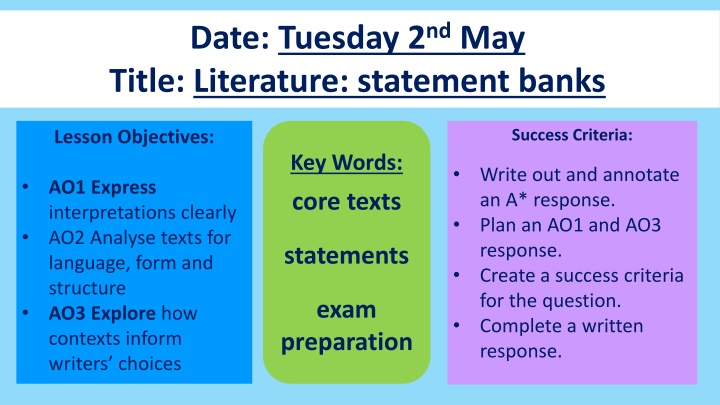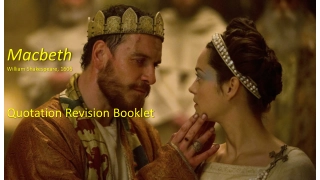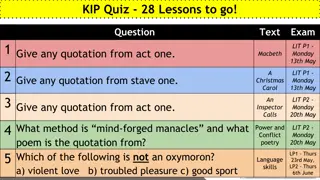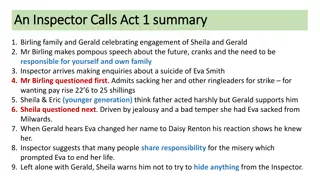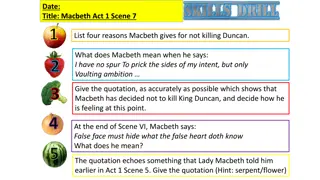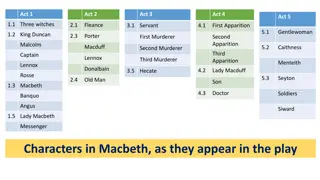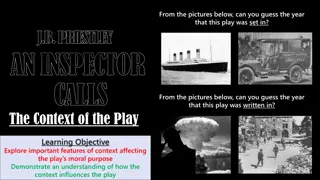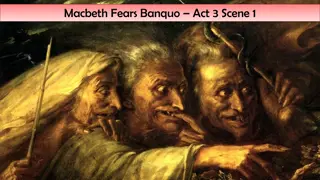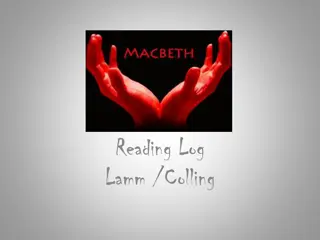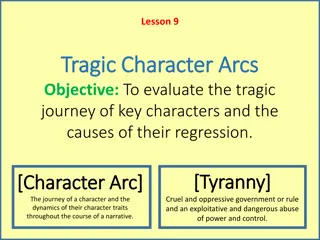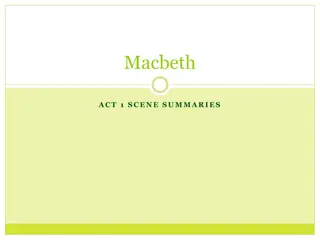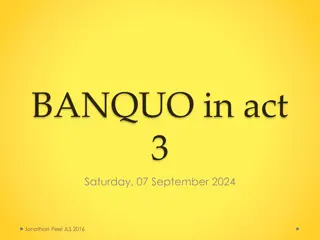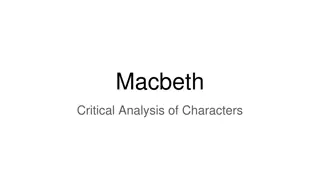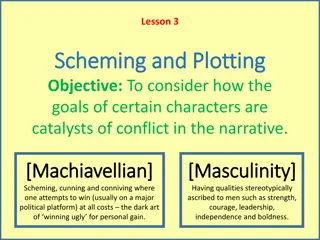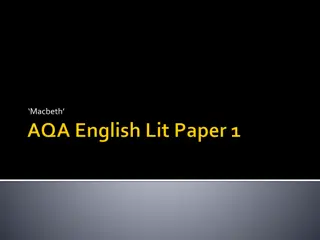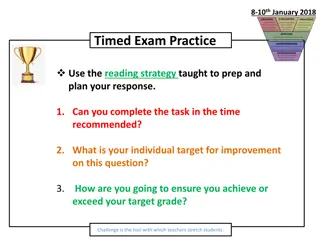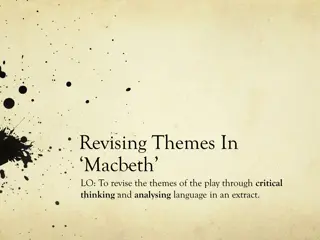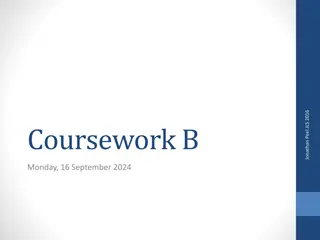Examining Shakespeare's Macbeth, Priestley's An Inspector Calls, and Stevenson's Jekyll and Hyde
Delve into the contextual motivations behind the writing of Macbeth, An Inspector Calls, and Jekyll and Hyde, exploring how Shakespeare, Priestley, and Stevenson crafted their narratives to convey social commentary and challenge prevailing ideologies. Uncover the intricate layers of symbolism, character development, and thematic exploration within these classic works, shedding light on the authors' intent and the historical frameworks that shaped their storytelling.
Download Presentation

Please find below an Image/Link to download the presentation.
The content on the website is provided AS IS for your information and personal use only. It may not be sold, licensed, or shared on other websites without obtaining consent from the author.If you encounter any issues during the download, it is possible that the publisher has removed the file from their server.
You are allowed to download the files provided on this website for personal or commercial use, subject to the condition that they are used lawfully. All files are the property of their respective owners.
The content on the website is provided AS IS for your information and personal use only. It may not be sold, licensed, or shared on other websites without obtaining consent from the author.
E N D
Presentation Transcript
Date: Tuesday 2nd May Title: Literature: statement banks Success Criteria: Lesson Objectives: Key Words: core texts Write out and annotate an A* response. Plan an AO1 and AO3 response. Create a success criteria for the question. Complete a written response. AO1Express interpretations clearly AO2 Analyse texts for language, form and structure AO3Explore how contexts inform writers choices statements exam preparation
Key Words: Success Criteria: Lesson Objectives: AO1Express interpretations clearly. AO3Explore how contexts inform writers choices. Write out and annotate an A* response. Plan a response for Part B. Create a success criteria for the question. Complete a written response. context personal response Statement Banks Going into the exam, it is really important that you have a bank of high level evaluative statements in your mind for each text. That way, no matter what the question, you should have some high level ideas to include in your response.
Macbeth: examples It was well known that King James was fascinated by witchcraft; Shakespeare might have been trying to win his approval by introducing the figures of the 'three weird sisters' into the play. Why did Shakespeare write the play Macbeth? Shakespeare wrote the play Macbeth as propaganda to ensure that his audience would be dissuade from committing regicide. Shakespeare highlights the importance of the Divine Right of Kings by showing a Jacobean audience the deadly consequences of killing a King. Shakespeare wove direct references to the Gunpowder plot into Macbeth to celebrate the discovery of the terrible scheme and to show his audience the consequences of committing treason. Shakespeare uses the play Macbeth to challenge the gender notions of the 17th century.
An Inspector Calls: examples Priestley drives the character of the Inspector through the play to challenge the characters and the audience to change their ideas. The Inspector is a mouthpiece for Priestley himself; he represents Priestley s socialist views. Why did Priestley write the play An Inspector Calls? The Inspector is there as a warning to people like the Birlings and to drive forward a change in society. Priestley s main aim was to highlight the problems in society of 1912 and to make the audience appreciate that the problems would only be solved if people took responsibility for each other. Priestley personified his views into the character of Inspector Goole; it is a morality play aimed at teaching the audience a lesson.
Jekyll and Hyde Stevenson wrote the novella to highlight the fact that there are two sides to mankind: good and evil. Victorians believed that science had become dangerous, people thought meddling in matters which only God had control over would end badly; this is what Jekyll does in the novella. Why did Stevenson write the novella Jekyll and Hyde? Stevenson presents a 'war of attitudes' between Jekyll and Lanyon, and both men are destroyed by their own beliefs; Lanyon by his inability to imagine or accept a world beyond the rational and scientific, Jekyll by accepting and unleashing the dark powers that lie beyond the norm. Throughout the novella Stevenson presents a battle between science and religion. Stevenson uses juxtaposition throughout the novella, such as the beautiful Carew alongside the ape-like Hyde, to expose mankind s duality.
Key Words: Success Criteria: Lesson Objectives: AO1Express interpretations clearly. AO3Explore how contexts inform writers choices. Write out and annotate an A* response. Plan a response for Part B. Create a success criteria for the question. Complete a written response. context personal response Jekyll and Hyde: interesting information Jekyll is much bigger than Hyde. This is seen particularly when Hyde's small body is found in the much larger clothes of Dr Jekyll. Stevenson is perhaps suggesting Hyde is a smaller part of Jekyll, but that if people repress the bad in them it will take over and destroy them. Hyde is younger and more energetic than Jekyll. This suggests evil is something that develops later in life, after a period of childhood innocence. The two names seem to have a double meaning: The two syllables of Jekyll's name (Je and kyll) perhaps mean 'I kill' ( Jeis the French for I). In the last chapter, Jekyll describes how he tried to get rid of (kill) the Hyde in him. Hyde spelled as 'hide' suggests something hidden from view, or the rough skin of an animal. Jekyll is in some way trying to kill the hidden Hyde and his animal nature.
Key Words: Success Criteria: Lesson Objectives: AO1Express interpretations clearly. AO3Explore how contexts inform writers choices. Write out and annotate an A* response. Plan a response for Part B. Create a success criteria for the question. Complete a written response. context personal response Grade boundaries 0-1 - U 2-4 - 1 5-7 - 2 8-10 - 3 11 - 4 12 - 5 13 - 6 14 - 16 - 7 17 and above- 8 Select one question for each text and create a detailed essay plan. Each question is worth 20 marks.
